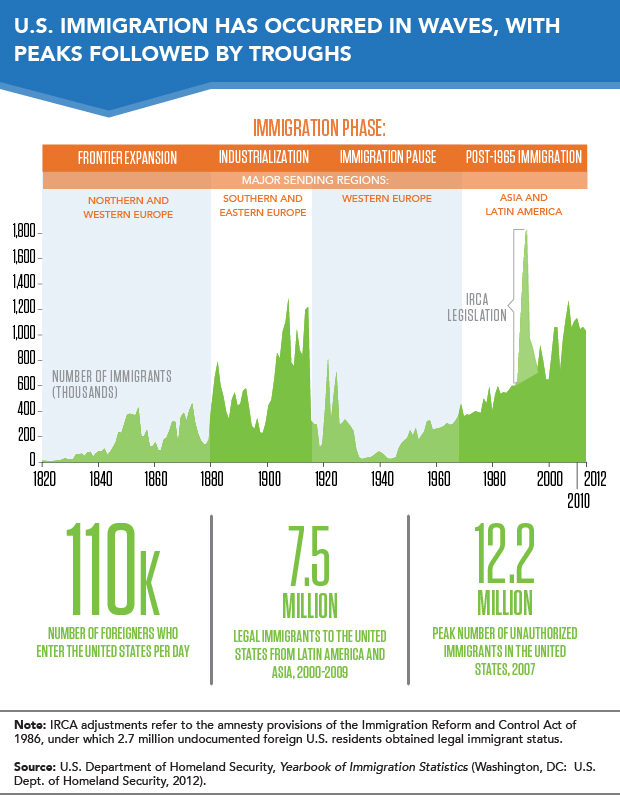What prompted the wave of immigration to the US in the early 1920s?
Nether the motto e pluribus unum (from many, 1), U.South. presidents frequently remind Americans that they share the immigrant experience of beginning afresh in the land of opportunity.one Immigration is widely considered to exist in the national interest, since information technology permits individuals to better themselves equally information technology strengthens the Us.
For its first 100 years, the United States facilitated immigration, welcoming foreigners to settle a vast country. Beginning in the 1880s, an era of qualitative immigration restrictions began equally sure types of immigrants were barred: prostitutes, workers with contracts that tied them to a particular employer for several years, and Chinese. In the 1920s, quantitative restrictions or quotas fix a ceiling on the number of immigrants accepted each twelvemonth.2
Immigration law inverse in 1965. Qualitative and quantitative restrictions were maintained, but national origin preferences that favored the entry of Europeans were dropped. U.Due south. immigration policy began to favor the entry of foreigners who had U.South. relatives and foreigners requested by U.Due south. employers. During the 1970s, the origins of most immigrants inverse from Europe to Latin America and Asia: Between 2000 and 2009 over three-fourths of the 10 one thousand thousand immigrants admitted were from Latin America and Asia.

U.S. immigration has occurred in waves, with peaks followed past troughs (see effigy). The first moving ridge of immigrants, by and large English-speakers from the British Isles, arrived earlier records were kept beginning in 1820. The 2nd wave, dominated by Irish and German Catholics in the 1840s and 1850s, challenged the dominance of the Protestant church and led to a backlash against Catholics, defused merely when the Ceremonious State of war practically stopped clearing in the 1860s.
The third wave, between 1880 and 1914, brought over 20 million European immigrants to the United states, an average of 650,000 a year at a fourth dimension when the United states of america had 75 million residents. Most southern and eastern European immigrants arriving via New York'southward Ellis Island found mill jobs in Northeastern and Midwestern cities. Third-wave European immigration was slowed first by World War I and then by numerical quotas in the 1920s.
Betwixt the 1920s and 1960s, immigration paused. Immigration was low during the Depression of the 1930s, and in some years more than people left the United States than arrived. Immigration rose after World State of war 2 ended, equally veterans returned with European spouses and Europeans migrated. The 4th wave began after 1965, and has been marked by rising numbers of immigrants from Latin America and Asia. The United States admitted an average 250,000 immigrants a year in the 1950s, 330,000 in the 1960s, 450,000 in the 1970s, 735,000 in the 1980s, and over i million a year since the 1990s.
Almost 110,000 foreigners enter the United States on a typical day. Three major entry doors exist: a front door for immigrants, a side door for temporary visitors, and a dorsum door for the unauthorized. Almost 3,100 foreigners a mean solar day receive immigrant visas or green cards that permit them to live, work, and become naturalized U.S. citizens after five years. Over 105,000 tourist, business, and pupil visitors make it; some stay simply a few days, while others stay for several years. Finally, over 1,500 unauthorized foreigners a day were settling in the The states until the 2008 recession reduced their number sharply. Half of the unauthorized eluded apprehension at the Mexico-U.Due south. border, while the others entered legally through the side door but violated the terms of their visitor visas by working or not departing.3
During the 1990s, contentious debates arose about the human relationship of immigrants and their children to the U.S. educational, welfare, and political systems; and more broadly, whether the clearing system served U.S. national interests. Since then, the immigration debate has centered on preventing the entry of terrorists, controlling unauthorized migration, and dealing with U.S. employers who asking foreigners to fill jobs.
Today, unauthorized migration is the main policy concern. The number of unauthorized foreigners peaked at 12.two million in 2007, cruel by most ane million during the contempo recession, and may have increased again with economic recovery. Debates over how to prevent unauthorized migration and deal with the unauthorized already living in the United States are polarized. Many Republicans, especially in the House of Representatives, adopt an enforcement-first approach—more agents and fences on the Mexico-U.S. border and a requirement that U.S. employers submit data on newly hired employees to prevent unauthorized workers from getting jobs. President Obama and many Democrats adopt "comprehensive immigration reform" that includes more border and interior enforcement to discourage entry and employment, but also a path to legal immigrant status.
In 2006 and 2013, the U.S. Senate approved comprehensive immigration reform bills that included a path to legalization. The Senate'south Border Security, Economical Opportunity, and Clearing Modernization Act of 2013 would:
- Pace up enforcement to deter illegal migration.
- Provide a 13-year path to U.S. citizenship for unauthorized foreigners who arrived in the United states before Dec. 31, 2011, and remained continuously since their arrival.
- Create new guest worker programs for low-skilled farm and nonfarm workers.
- Increase the number of temporary work visas bachelor to foreigners with higher degrees coming to the United States to fill jobs.
The House approved an enforcement-first neb in 2005 and has opted for a piecemeal arroyo to immigration reform in 2013, with bills that increase border and interior enforcement and expand guest worker programs for farm and information technology (Information technology) workers.
mccormickliblaingledy.blogspot.com
Source: https://www.prb.org/resources/trends-in-migration-to-the-u-s/
0 Response to "What prompted the wave of immigration to the US in the early 1920s?"
Post a Comment